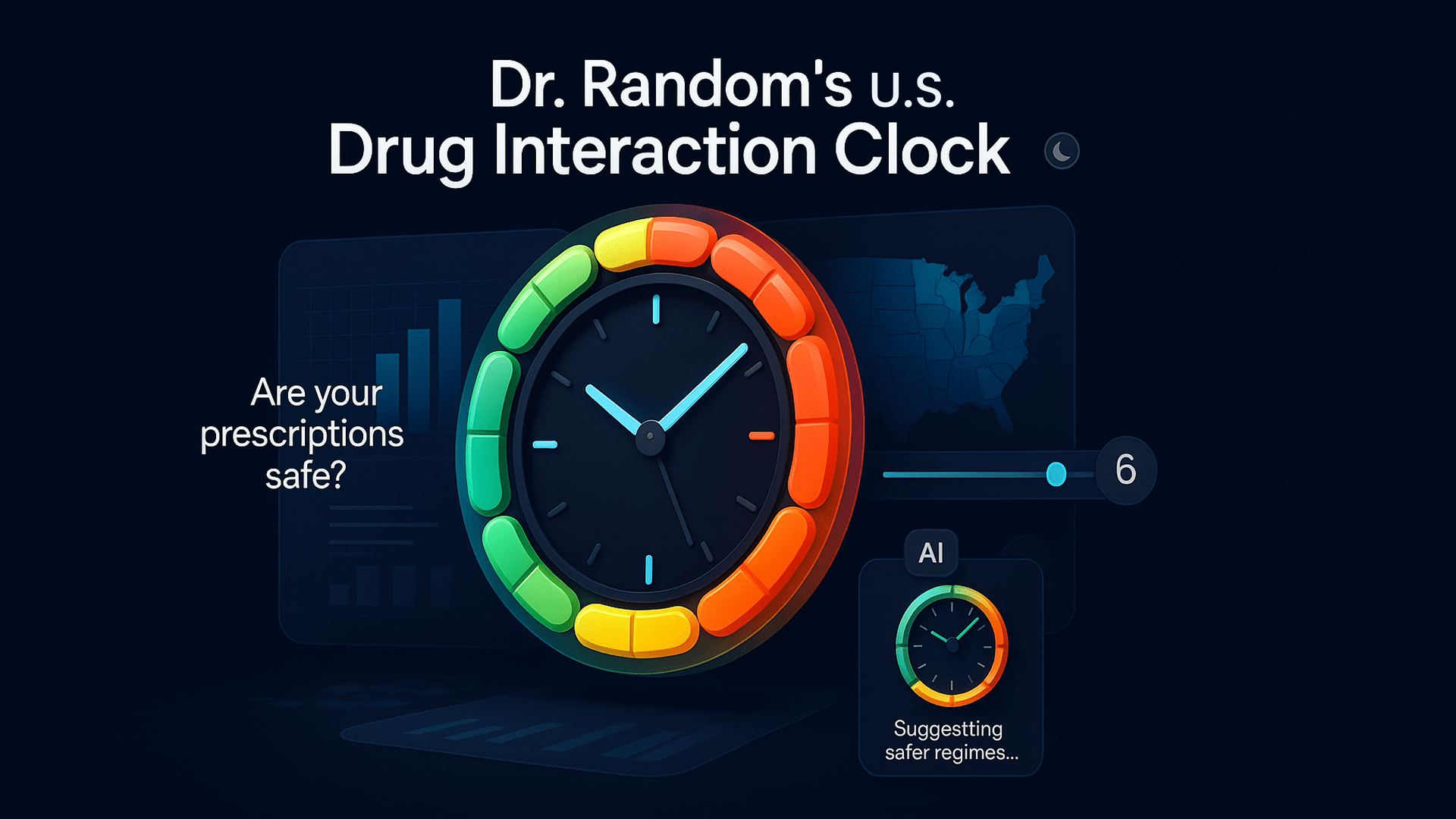Dr. Random is a very busy fictituous prescriber of medications (#), not aware that drug drug interactions may occur. However the randomly selected medications he compiles in 2-drugs, 3-drugs and up to 12-drugs samples are checked by SCHOLZ DataBank. Thereby possibly occurring drug drug interactions may be detected and statistically evaluated. The findings of this evaluation are presented in Dr. Randoms U.S. Drug Interaction Clock (DIClock) and give deep insights into the consequences which might happen when prescribing multiple drugs to patients, in particular as polypharmacy with 5 and more drugs. The potential random risk to prescribe contraindicated drug interactions is computed to 1.4% for 5-drug-medications and to 14.9% for 12-drug-medications.
SCHOLZ DataBank's Drug Interaction Clock provides so-to-say an assessment of the drug drug interaction risk when drugs are coincidently prescribed and drug drug interactions are not at all considered. Insofar it indicates the magnitude of the risk that - without thinking of drug drug interactions - patients might be harmed through increased morbidity, hospitalizations, irreversible damages, or increased mortality. It underscores at the same time the urgent need, to take all measures possible when prescribing drugs to avoid harmful drug drug interactions, especially in polypharmacy with multimorbide and elderly patients. The DIClock measures the frequency of potential drug drug interactions with the focus on serious interactions related to the following different classes:
SCHOLZ DataBank's Drug Interaction Clock provides so-to-say an assessment of the drug drug interaction risk when drugs are coincidently prescribed and drug drug interactions are not at all considered. Insofar it indicates the magnitude of the risk that - without thinking of drug drug interactions - patients might be harmed through increased morbidity, hospitalizations, irreversible damages, or increased mortality. It underscores at the same time the urgent need, to take all measures possible when prescribing drugs to avoid harmful drug drug interactions, especially in polypharmacy with multimorbide and elderly patients. The DIClock measures the frequency of potential drug drug interactions with the focus on serious interactions related to the following different classes:
Drug interactions which are contraindicated
Drug interactions whereby the combination of the drugs is not recommended
Drug interactions which are dangerous and may occur freqently, very frequently, or probably
Drug interactions which are dangerous and may occur occasionally or less frequently
SCHOLZ DataBank selects the samples for the interaction checks randomly out of about 163,000 Rx drugs and their NDCCODEs contained in the RxNorm database and available on the U.S. drug market.
Some 82 million multimorbide patients in the U.S. take daily 2, 3, or 4 drugs.
Some 66 million multimorbide patients in the U.S. are on polypharmacy with 5 and more drugs daily; most of these patients are elderly people (1). All these patients deserve that prescribing doctors and dispensing pharmacists should carefully check their medications for serious drug drug interactions, in partuclar, when complex polypharmacy may produce contraindications in many prescription scenarios possible.
Dr. Random's U.S. Drug Interaction Clock opens new prospectives to gain a better understanding of the magnitude of the drug drug interaction problem. It will be helpful to assess the potential risk of medical errors due to polypharmacy and drug drug interactions. In particular special drug risks, their consequences and costs, may be assessed and compared in the future in the context of prescribing multiple drugs: per drug, per drug class, per medication, per therapy regimen, per polypharmacy scenario, per patient, per individual patient group, for example with different renal stages or pharmacogenetics, and per whole populations of states or countries. Benchmarking and Drug Utilization Review (DUR) may also be supported by comparing potential drug interaction risks and their occurrence in written prescriptions.
Wolfgang Scholz
Founder
Click here to have a look at Dr. Random's U.S. Drug Interaction Clock
# Please note that Dr. Random in this context is not a real but a fictitious person!
Literature on demand
Dr. Random's U.S. Drug Interaction Clock opens new prospectives to gain a better understanding of the magnitude of the drug drug interaction problem. It will be helpful to assess the potential risk of medical errors due to polypharmacy and drug drug interactions. In particular special drug risks, their consequences and costs, may be assessed and compared in the future in the context of prescribing multiple drugs: per drug, per drug class, per medication, per therapy regimen, per polypharmacy scenario, per patient, per individual patient group, for example with different renal stages or pharmacogenetics, and per whole populations of states or countries. Benchmarking and Drug Utilization Review (DUR) may also be supported by comparing potential drug interaction risks and their occurrence in written prescriptions.
Wolfgang Scholz
Founder
Click here to have a look at Dr. Random's U.S. Drug Interaction Clock
# Please note that Dr. Random in this context is not a real but a fictitious person!
Literature on demand

